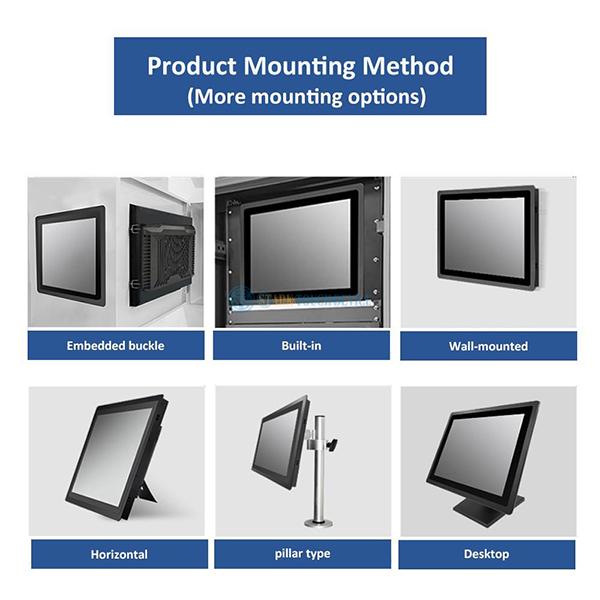Welcome STARK TOUCH DEVICE!
Solutions
Troubleshooting for the flashing power indicator light on industrial control computers
Troubleshooting Industrial Control Computer Power LED Flashing Issues
Power LED flashing on industrial control computers (ICCs) often signals underlying hardware or software malfunctions. This guide provides systematic steps to diagnose and resolve such issues, focusing on practical solutions without product-specific recommendations.

Initial Diagnostic Steps
1. Verify Power Supply Integrity
Check if the power cable is securely connected to both the ICC and the outlet. Test the outlet with another device to confirm functionality.
Inspect the power supply unit (PSU) for physical damage, such as burnt components or swollen capacitors. Use a multimeter to measure voltage output (e.g., 12V/24V rails) and ensure stability within manufacturer specifications.
For redundant PSUs, verify that both units are operational and properly synchronized.
2. Examine External Connections
Disconnect and reconnect all peripherals, including monitors, USB devices, and network cables. Loose or damaged connectors can trigger intermittent power cycling.
Test with minimal hardware (e.g., single monitor, no external drives) to isolate compatibility issues.
3. Observe LED Patterns
Document the flashing frequency (e.g., slow vs. rapid blinks) and sequence. Some ICCs use LED codes to indicate specific errors (e.g., three short blinks for RAM failure). Refer to the motherboard manual for interpretation.
Resolving Common Hardware Failures
Memory Module Issues
Remove and reseat RAM sticks, ensuring they click into place. Test each module individually in different slots to rule out slot or stick failures.
Clean gold contacts with isopropyl alcohol and a lint-free cloth if oxidation is suspected.
CPU and Motherboard Problems
Inspect the CPU socket for bent pins or debris. Reseat the processor carefully, applying even pressure.
Check for bulging or leaking capacitors on the motherboard, which indicate component degradation. Replace the motherboard if physical damage is evident.
Storage Device Conflicts
Disconnect all non-essential drives (e.g., secondary HDDs/SSDs) and attempt to boot with only the primary storage device.
Enter BIOS/UEFI to verify if the system detects the boot drive. If not, reseat the drive or test it in another system.
Addressing Software and Firmware Glitches
BIOS/UEFI Corruption
Reset BIOS settings to default by removing the CMOS battery for 1–2 minutes or using the motherboard jumper.
Update BIOS firmware to the latest stable version, following manufacturer instructions precisely. Avoid interruptions during the process.
Operating System Errors
Boot into safe mode (if possible) to check for driver conflicts or corrupted system files. Use tools like
sfc /scannow(Windows) orfsck(Linux) to repair file systems.Reinstall the OS as a last resort, ensuring backups of critical data are available.
Firmware and Driver Mismatches
Verify that all device drivers (e.g., chipset, storage controllers) are compatible with the OS version. Outdated drivers can cause hardware initialization failures.
Check for firmware updates for peripherals like RAID controllers or network adapters.
Environmental and Physical Factors
Thermal Management
Clean dust from heatsinks, fans, and ventilation grills using compressed air. Clogged airflow can trigger overheating protection circuits, causing intermittent shutdowns.
Monitor ambient temperature with an infrared thermometer. Ensure the ICC operates within specified limits (typically 0–40°C for industrial environments).
Electromagnetic Interference (EMI)
Relocate the ICC away from high-voltage equipment, motors, or wireless transmitters. Use shielded cables for critical connections.
Ground the chassis properly to prevent static buildup.
Power Quality Issues
Install an uninterruptible power supply (UPS) with voltage regulation to protect against surges, sags, or frequency fluctuations.
Test the ICC on a different power circuit to rule out building-wide electrical problems.
Advanced Troubleshooting Techniques
Post Diagnostics
If the system powers on but fails to POST (Power-On Self-Test), listen for beep codes. Common patterns include:
Single long beep: RAM failure.
Continuous beeps: CPU or motherboard issue.
Use a POST card to identify the exact point of failure during boot.
Component Isolation
Swap known-good components (e.g., RAM, PSU) from a working system to test for compatibility.
For embedded ICCs, consult the manufacturer for diagnostic tools or firmware recovery procedures.
Logging and Analysis
Enable system event logging in BIOS/UEFI or OS to capture error messages during crashes.
Use hardware monitoring tools to track voltage, temperature, and fan speeds in real time.
By following these structured steps, technicians can efficiently pinpoint and resolve power LED flashing issues in industrial control computers, minimizing downtime and ensuring operational reliability.


